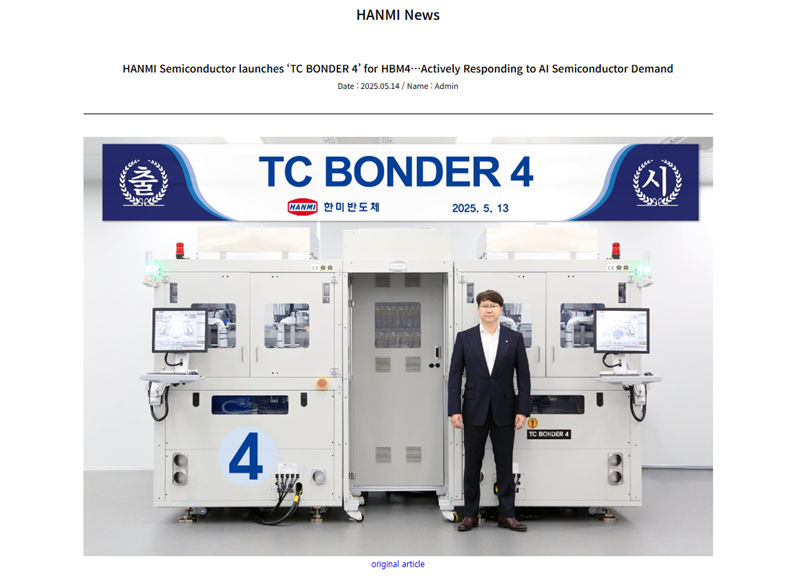As global demand for artificial intelligence (AI) and high-performance computing (HPC) surges, high-bandwidth memory (HBM) has emerged as a critical technology for next-generation computing infrastructure. HBM employs 3D-stacked DRAM layers interconnected through silicon vias (TSVs), driving higher requirements for semiconductor manufacturing and packaging equipment. In response, major semiconductor equipment firms—including Hanmi Semiconductor, AMEC, and ACM Research (Shanghai)—are aggressively expanding their HBM and advanced packaging capabilities.
1. Hanmi Semiconductor Establishes Dedicated HBM4 Equipment Team
South Korea's Hanmi Semiconductor recently announced the formation of a specialized team to focus on HBM4-related equipment development. On May 14, the company unveiled its TC Bonder 4, a next-generation thermal compression bonding system designed for HBM4 production.
Hanmi Chairman Kwak Dong Shin emphasized that the TC Bonder 4's improved efficiency and precision will enable customers to mass-produce HBM4 in late 2024. Compared to HBM3E, HBM4 delivers 60% higher speed, 30% lower power consumption, and supports 16-layer stacking with 2,048 TSV interconnects, significantly boosting data transfer performance.
Founded in 1980, Hanmi specializes in back-end semiconductor packaging equipment, including TC bonders, wafer-level packaging systems, and wire bonders. Its expertise in vertical stacking and precision interconnects has made it a key supplier for memory and foundry leaders.

2. AMEC Expands Footprint in HBM and Advanced Packaging
On June 9, AMEC disclosed its comprehensive HBM and advanced packaging strategy during an investor Q&A. The company's product portfolio now covers etching, CVD, PVD, and wafer metrology/inspection tools—critical for HBM manufacturing.
AMEC highlighted breakthroughs in TSV deep silicon etching, a core HBM process, and recently launched its capacitively coupled plasma (CCP) etching system. These advancements position AMEC to support high-performance AI chip packaging and other emerging applications.
When asked about dedicated HBM equipment, AMEC noted its broad capabilities in advanced packaging, particularly in TSV technology, where it has achieved production-ready performance.
3. ACM Research (Shanghai) Secures $448M Funding for R&D Push
On June 6, ACM Research (Shanghai) received approval for a RMB 4.482 billion (~$618M) private placement, earmarked for three key initiatives:
R&D and process testing platforms (RMB 922M)
High-end semiconductor equipment upgrades (RMB 2.255B)
Working capital (RMB 1.304B)
While the filing didn't explicitly mention HBM, ACM's expertise in wet cleaning and electroplating aligns with critical HBM processes. The company's Ultra C series (megasonic cleaning) and Ultra ECP GIII (copper electroplating) platforms address HBM's stringent requirements for TSV cleaning, micro-bump formation, and redistribution layer (RDL) deposition.
ACM's technologies ensure high-yield, defect-free surfaces for 3D-stacked DRAM—a decisive factor in HBM production.
Industry Outlook
With HBM adoption accelerating in AI/GPU markets, Hanmi, AMEC, and ACM are poised to play pivotal roles in enabling next-generation packaging. Their innovations in bonding, etching, cleaning, and electroplating will shape the future of high-performance memory and computing.
(Word count: 398 | Optimized for clarity, technical accuracy, and industry relevance.)| Optimized for clarity, technical accuracy, and industry relevance.)
Key Terms:
HBM (High-Bandwidth Memory) – 3D-stacked DRAM for AI/HPC
TSV (Through-Silicon Via) – Vertical interconnects in advanced packaging
TC Bonder – Thermal compression bonding tool for chip stacking
ECP (Electro-Chemical Plating) – Critical for TSV/micro-bump metallization
+86 191 9627 2716
+86 181 7379 0595
8:30 a.m. to 5:30 p.m., Monday to Friday
